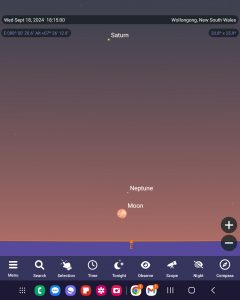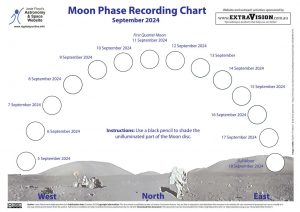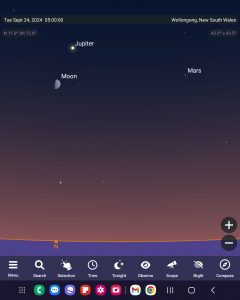Use the finder charts on this page to guide you to where to look for the planets in September 2024.
Don’t have a telescope to look at the planets or Moon? Remember you can contact your local astronomical society about holding a telescope viewing session for your school, youth group or other organisation.
A few pointers:
- All planets visible to the unaided eye look like stars. Planets visible to the unaided eye include Mercury, Venus, Earth (look down!), Mars, Jupiter and Saturn.
- Planet visibility in 2024
- TimeandDate.com will generate customised visiblity information for your location. Just make sure you specify where you are.
- You can download planet rise and set times for different Australian capital cities from Quasar Publishing’s site.
- In a telescope, Uranus and Neptune are visible as tiny discs. The minor planet Pluto remains looking like a star in even the largest amateur telescope.
- Stars are shown to magnitude 5 on the charts unless otherwise noted. This is a compromise between what you would see from the light polluted skies of a city (where you will see significantly less stars) and dark country skies (where you will see significantly more stars).
- Unless otherwise noted, the finder charts are prepared for Wollongong, NSW. The charts will be useful for elsewhere in Eastern Australia including Canberra.
- Planet finder charts usually focus on when the Moon is next to a particular planet. That lets beginning astronomers use the Moon as a ‘signpost’ to find that particular planet.
5 to 18 September 2024 – Record the changing appearance of the Moon – Evening twilight sky
An easy but rewarding observing activity is to record the changing appearance of the Moon between New Moon and Full Moon. If you observe it at the same time each evening (end of evening twilight), you will notice that the Moon moves from the West to the East. This movement demonstrates the Moon’s movement in it’s orbit around the Earth. Download the recording chart.
6 September 2024 – Moon and Venus – Evening twilight
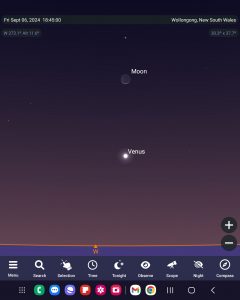
8 September 2024 – Saturn at opposition
17 September 2024 – Moon and Saturn close – Early evening sky
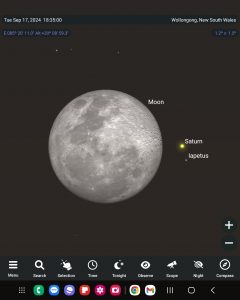
17 September 2024 – ‘Zoomed in’ view of Full Moon and Saturn close – Early evening sky
Tonight represents a uncommon opportunity to view the Earth’s Moon plus Saturn and its rings at the same time through a telescope. Be warned that the Moon will be very bright!
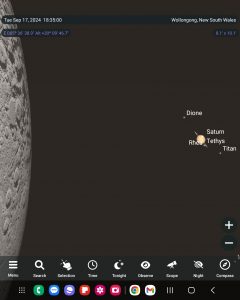
18 September 2024 – Full Moon / ‘Super Moon’
2024’s first ‘Super Moon’ will occur at 12.34 pm AEST (Wednesday 18 September 2024) today. The Moon will be below the Wollongong, NSW horizon at this time. The Moon does not rise until 6.01 pm AEST for Wollongong observers. The next and last ‘Super Moon’ of 2024 occurs on 17 October 2024.
